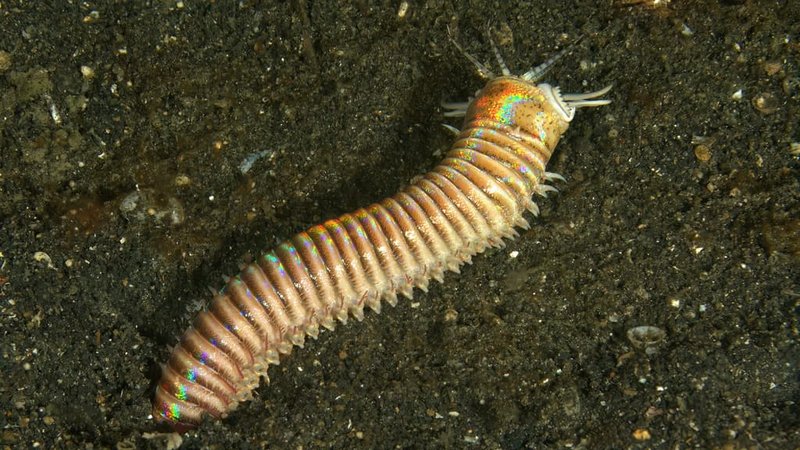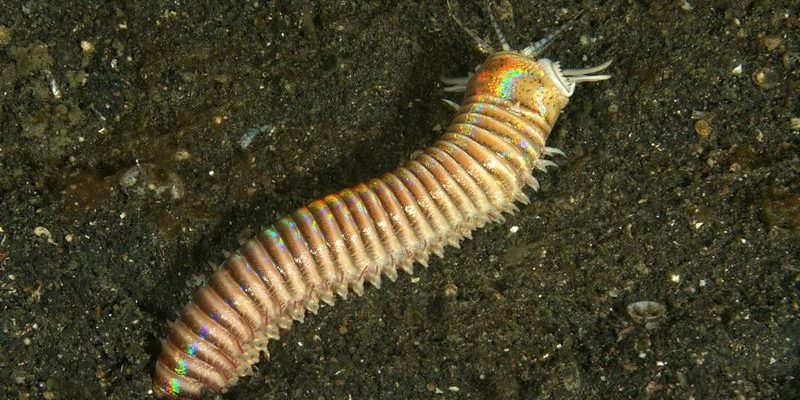
So, what exactly is a Bobbit worm, and how can you identify various species around the globe? Imagine a long, colorful worm peeking out of its burrow, with a mouth filled with sharp jaws. Their ability to remain hidden while snatching up prey in the blink of an eye makes them one of the ocean’s stealthiest predators. Let’s dive into this identification guide and explore the captivating world of Bobbit worms.
What Are Bobbit Worms?
Bobbit worms are marine polychaete worms, part of the Eunicidae family. They’re known for their unique hunting technique and striking appearance. These worms can grow up to 10 feet long, though most species average between 3 to 5 feet. When you see one, it might look like a vibrant tube or a long, slithering creature, depending on the species and habitat.
Their bodies are segmented, and they often display brilliant colors like greens, reds, and blues that help camouflage them within coral reefs or seagrasses. If you’re looking for them, you might spot their long, antenna-like appendages sticking out of the ocean floor, indicating a hidden Bobbit worm beneath.
Interestingly, their hunting method is akin to a predator’s ambush tactic. They lie in wait, camouflaged in their environment, and then, with lightning speed, they strike. Their jaws can be quite fearsome, making them efficient hunters of fish, crustaceans, and even other worms. You might be wondering how they manage this—it’s all about those *sharp, powerful jaws* that can snap shut in a split second.
Common Species of Bobbit Worms
There are several types of Bobbit worms found across the globe, each with its own unique characteristics. Some of the most well-known species include:
- Eunice aphroditois: This is perhaps the most famous Bobbit worm. Known for its impressive length, it can grow up to 10 feet! Typically found in the Indo-Pacific region, its vibrant colors make it a standout.
- Eunice norvegica: Found in the North Atlantic, this species has a more muted color palette. It’s smaller than its cousin, typically reaching lengths of 3 to 4 feet.
- Eunice caribea: As the name suggests, this species can be found in the Caribbean Sea. It often features bright reds and yellows, making it a visual treat for divers.
Each of these species has adapted to its environment, showcasing how diverse and fascinating life can be beneath the waves. Whether you’re snorkeling in the Caribbean or deep-sea diving in the Pacific, you’re likely to encounter at least one of these species if you’re lucky!
Identifying Bobbit Worms
Identifying Bobbit worms can be tricky. They often blend in seamlessly with their surroundings, so you need to look closely. Start by noticing the color and texture of the worm. The vibrant hues can be key indicators of the species.
You’ll also want to pay attention to the size. As mentioned earlier, different species can grow to various lengths. Generally, if you’re observing a particularly long worm, it’s likely the *Eunice aphroditois*. When disturbed, the worm can retract quickly into its burrow, making it a bit challenging to spot. It’s like trying to catch a glimpse of a shy cat hiding under the bed!
Additionally, their mouthparts are a significant identifying feature. These sharp jaws can be quite intimidating and help distinguish one species from another. If you see a prominent set of jaws, you’re likely dealing with a Bobbit worm!
Habitat of Bobbit Worms
Bobbit worms thrive in various marine environments. They primarily dwell in **sandy or muddy substrates**, often found in coral reefs or seagrass beds. These habitats provide ample cover and a food source for their predatory lifestyle. You might find them nestled in their burrows, which can be several feet deep, making them challenging to spot.
In terms of geographical distribution, Bobbit worms are predominantly found in tropical and subtropical waters. The warm ocean currents and rich biodiversity of regions like the Indo-Pacific and the Caribbean make it a perfect home for these unique worms. So, if you’re planning a diving trip in these areas, keep your eyes peeled for these remarkable creatures!
The Role of Bobbit Worms in the Ecosystem
Bobbit worms play a vital role in their ecosystems, acting as both predators and prey. As predators, they help regulate populations of smaller fish and invertebrates, contributing to the overall balance in their habitats. Their hunting techniques also promote the health of the seafloor by aerating the substrate as they burrow, which can benefit other marine life.
On the flip side, Bobbit worms themselves serve as prey for larger animals, including fish and sea turtles. This predator-prey relationship is essential for maintaining the marine food web. Without creatures like the Bobbit worm, the delicate balance of underwater ecosystems could be disrupted.
Moreover, these worms contribute to the diversity of marine life. You might think of them as the unsung heroes of the ocean—you rarely see them, but they play a crucial part in keeping their surroundings healthy and thriving.
Bobbit Worms in Aquariums
If you’ve ever considered adding a Bobbit worm to an aquarium, it’s important to understand their needs. These creatures can be fascinating to observe but have specific requirements. They thrive in saltwater environments and need ample space to burrow and hunt.
Setting up a tank with plenty of hiding spots, like rocks and substrates, mimics their natural habitat. You’ll want to ensure the water quality is high and stable, as Bobbit worms are sensitive to changes in their environment. Here’s a quick checklist:
- Maintain proper water salinity (around 1.020 to 1.025).
- Provide plenty of space for burrowing—think large sand beds.
- Keep tank mates in mind; avoid smaller fish that could become lunch!
Keep in mind that while they may look cool, they can also be quite aggressive. If you’re not careful, a Bobbit worm could decimate your smaller fish populations. So, think twice before adding one to your home aquarium!
Conservation and Threats to Bobbit Worms
Like many ocean-dwelling creatures, Bobbit worms face threats from human activity. Habitat destruction, pollution, and climate change are significant concerns for these unique worms and their ecosystems. As coastal areas are developed and pollution increases, the environments that sustain Bobbit worms are increasingly at risk.
Additionally, overfishing can affect their prey populations, indirectly impacting Bobbit worms. If their food sources dwindle, it could lead to a decline in their populations as well. Conservation efforts focused on **marine protected areas** are essential to safeguarding these creatures and their habitats.
By raising awareness about the existence and role of Bobbit worms in the ecosystem, we can help promote healthier oceans and more balanced marine environments. Remember, every little critter plays a part in the ocean’s big story.
Bobbit worms might not be the most well-known ocean residents, but they certainly deserve our attention. From their keen hunting abilities to their vibrant appearances, these worms offer a glimpse into the richness of marine biodiversity. As we’ve explored, they play crucial roles in their ecosystems while also facing various threats from human activities.
So, whether you’re a seasoned marine biologist or just a curious beachgoer, understanding and recognizing Bobbit worm species can help you appreciate the beauty and complexity of life underwater. Next time you find yourself near the ocean, take a moment to consider the hidden wonders—who knows, you might just spot a Bobbit worm peeking out from its burrow!

